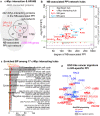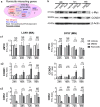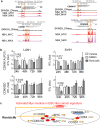A c-Myc-regulated stem cell-like signature in high-risk neuroblastoma: A systematic discovery (Target neuroblastoma ESC-like signature)
- PMID: 28246384
- PMCID: PMC5427913
- DOI: 10.1038/s41598-017-00122-x
A c-Myc-regulated stem cell-like signature in high-risk neuroblastoma: A systematic discovery (Target neuroblastoma ESC-like signature)
Abstract
c-Myc dysregulation is hypothesized to account for the 'stemness' - self-renewal and pluripotency - shared between embryonic stem cells (ESCs) and adult aggressive tumours. High-risk neuroblastoma (HR-NB) is the most frequent, aggressive, extracranial solid tumour in childhood. Using HR-NB as a platform, we performed a network analysis of transcriptome data and presented a c-Myc subnetwork enriched for genes previously reported as ESC-like cancer signatures. A subsequent drug-gene interaction analysis identified a pharmacogenomic agent that preferentially interacted with this HR-NB-specific, ESC-like signature. This agent, Roniciclib (BAY 1000394), inhibited neuroblastoma cell growth and induced apoptosis in vitro. It also repressed the expression of the oncogene c-Myc and the neural ESC marker CDK2 in vitro, which was accompanied by altered expression of the c-Myc-targeted cell cycle regulators CCND1, CDKN1A and CDKN2D in a time-dependent manner. Further investigation into this HR-NB-specific ESC-like signature in 295 and 243 independent patients revealed and validated the general prognostic index of CDK2 and CDKN3 compared with CDKN2D and CDKN1B. These findings highlight the very potent therapeutic benefits of Roniciclib in HR-NB through the targeting of c-Myc-regulated, ESC-like tumorigenesis. This work provides a hypothesis-driven systems computational model that facilitates the translation of genomic and transcriptomic signatures to molecular mechanisms underlying high-risk tumours.
Conflict of interest statement
The authors declare no competing financial interests.
Figures






Similar articles
-
Incorporating genomic, transcriptomic and clinical data: a prognostic and stem cell-like MYC and PRC imbalance in high-risk neuroblastoma.BMC Syst Biol. 2017 Oct 3;11(Suppl 5):92. doi: 10.1186/s12918-017-0466-5. BMC Syst Biol. 2017. PMID: 28984200 Free PMC article.
-
In silico discovery of a FOXM1 driven embryonal signaling pathway in therapy resistant neuroblastoma tumors.Sci Rep. 2018 Nov 30;8(1):17468. doi: 10.1038/s41598-018-35868-5. Sci Rep. 2018. PMID: 30504901 Free PMC article.
-
Roniciclib down-regulates stemness and inhibits cell growth by inducing nucleolar stress in neuroblastoma.Sci Rep. 2020 Jul 31;10(1):12902. doi: 10.1038/s41598-020-69499-6. Sci Rep. 2020. PMID: 32737364 Free PMC article.
-
Targeting Oncogenic Transcriptional Networks in Neuroblastoma: From N-Myc to Epigenetic Drugs.Int J Mol Sci. 2021 Nov 28;22(23):12883. doi: 10.3390/ijms222312883. Int J Mol Sci. 2021. PMID: 34884690 Free PMC article. Review.
-
Emerging therapeutic targets for neuroblastoma.Expert Opin Ther Targets. 2020 Sep;24(9):899-914. doi: 10.1080/14728222.2020.1790528. Epub 2020 Oct 6. Expert Opin Ther Targets. 2020. PMID: 33021426 Free PMC article. Review.
Cited by
-
Self-Renewal and Pluripotency in Osteosarcoma Stem Cells' Chemoresistance: Notch, Hedgehog, and Wnt/β-Catenin Interplay with Embryonic Markers.Int J Mol Sci. 2023 May 7;24(9):8401. doi: 10.3390/ijms24098401. Int J Mol Sci. 2023. PMID: 37176108 Free PMC article. Review.
-
Synthetic Heterocyclic Derivatives as Kinase Inhibitors Tested for the Treatment of Neuroblastoma.Molecules. 2021 Nov 23;26(23):7069. doi: 10.3390/molecules26237069. Molecules. 2021. PMID: 34885651 Free PMC article. Review.
-
Stable expansion of high-grade serous ovarian cancer organoids requires a low-Wnt environment.EMBO J. 2020 Mar 16;39(6):e104013. doi: 10.15252/embj.2019104013. Epub 2020 Feb 3. EMBO J. 2020. PMID: 32009247 Free PMC article.
-
A subset analysis of a phase II trial evaluating the use of DFMO as maintenance therapy for high-risk neuroblastoma.Int J Cancer. 2020 Dec 1;147(11):3152-3159. doi: 10.1002/ijc.33044. Epub 2020 May 24. Int J Cancer. 2020. PMID: 32391579 Free PMC article. Clinical Trial.
-
MYC Drives a Subset of High-Risk Pediatric Neuroblastomas and Is Activated through Mechanisms Including Enhancer Hijacking and Focal Enhancer Amplification.Cancer Discov. 2018 Mar;8(3):320-335. doi: 10.1158/2159-8290.CD-17-0993. Epub 2017 Dec 28. Cancer Discov. 2018. PMID: 29284669 Free PMC article.
References
Publication types
MeSH terms
Substances
Grants and funding
LinkOut - more resources
Full Text Sources
Other Literature Sources
Medical
Research Materials
Miscellaneous

